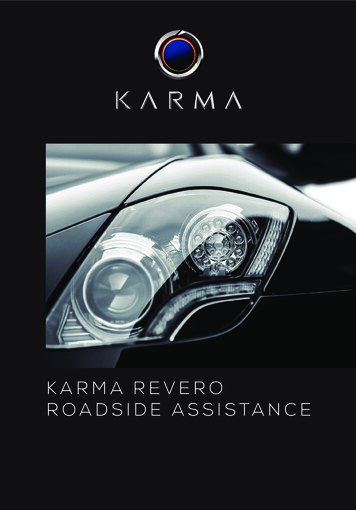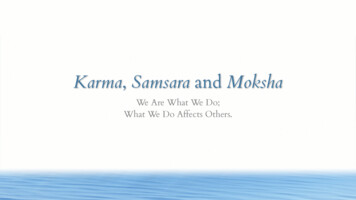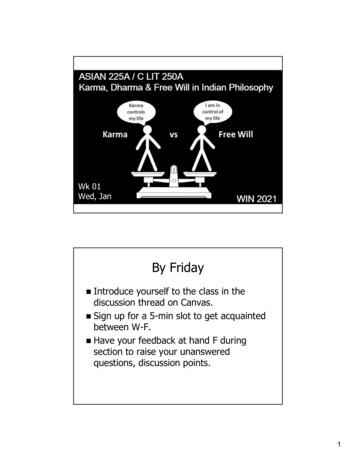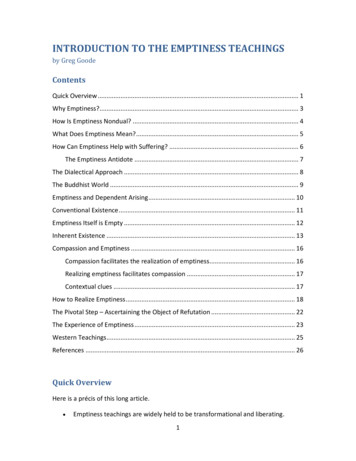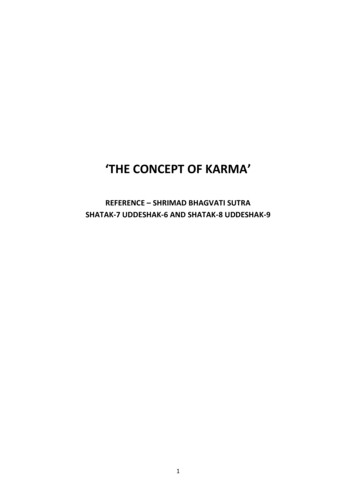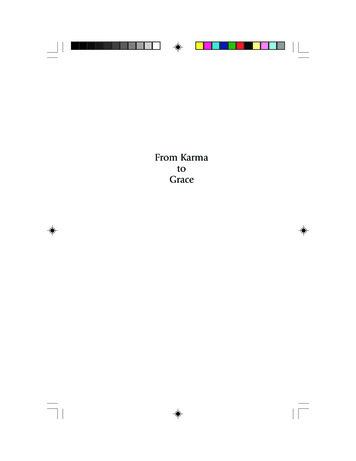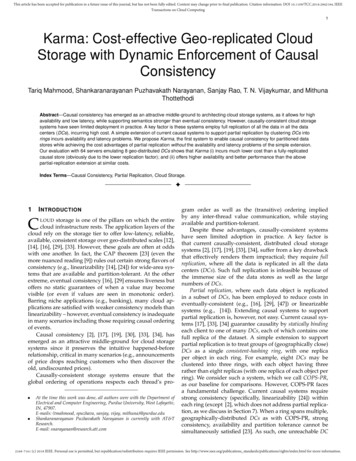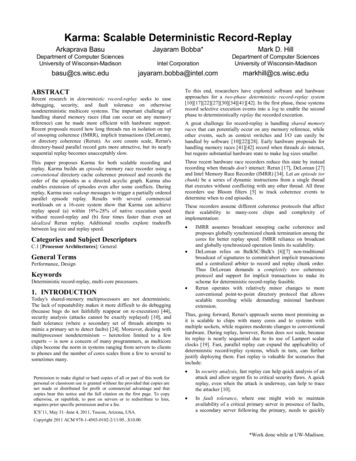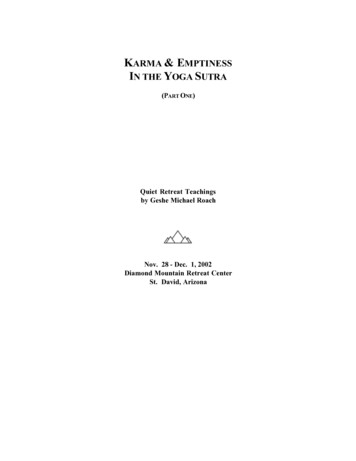
Transcription
KARMA & EMPTINESSIN THE YOGA SUTRA(PART ONE)Quiet Retreat Teachingsby Geshe Michael RoachNov. 28 - Dec. 1, 2002Diamond Mountain Retreat CenterSt. David, Arizona
Afternoon: Day One ] November 28, 2002Geshe Michael RoachI think some of you may have read the book called The Garden, and today is the very daythat the hero of the story meets the young girl, who turns out to be some kind of Angel.TI thought I’d tell the story about how I learned to cut diamonds. I was already working ina diamond company, but I wanted to learn how to cut them. I looked for a long time to find ateacher, and it was very difficult. Diamond cutting is almost like a secret skill that people don’tteach easily, and for months I looked . . . no one would teach me.But one day I mentioned to my co-manager . . . I had a very beautiful, incredible womanwho was my co-manager. Her name is Rachel, Rachel (Hebrew pronunciation). And so I told herI had trouble finding a teacher and she said, “Oh, my husband is a teacher.” So we made all thearrangements and I went to the place.They work a lot on Sundays because Saturday is the holy day. And so it was a Sundaymorning in Manhattan, and mid-town in the diamond district was all shut down. I remembergoing to this dark elevator and up, I think about fifteen floors, and then into this room. And youpass through a lot of security. And then I came in and it was incredible, it was a dark room,almost all the lights out, the windows are covered with this gray powder, and this beautiful manmet me, and his name is Schmuel, Shmuelof, and he’s Israeli. He is not a big man but he was aboxer, before a diamond cutter, for the Israelis’ Olympic team. And then later he was a sergeantin the army, and during the Seven Day War he fought. And I think all this changed his mind andhe. . . he is a very warm and extremely gentle man.And so he took me right in and he said, “Okay Michael (Hebrew pronunciationthroughout), this is how we do it.” And he pulled out a stone from a special box, and . . . ifyou’ve ever seen a raw diamond, they don’t look much like diamond. It looked like a potato—small, and it was olive green, like army green.And he said, “We’re going to start with this stone.”And I said, “How big is it?”And he said, “Three carats.”And I said, “Schmuel, I don’t know anything . . . a three carat diamond could be worthfifty or one hundred thousand dollars.”And he said, “Don’t worry.”And so he put this little lumpy thing in my hand and he pulled out a thing called a tang.Most of the words are from Amsterdam — Dutch, and he said, “This is a tang.” It means a“tongue,” and it’s a holder, like a wooden stick, with two legs on the back. You put the diamondin the front, and there’s a bowl of lead, called a dop. Diamond cutting hasn’t changed in aboutthree hundred years.So he said, “First Michael, we’re going to put ze diamond in da dop.”So I said, “Okay.”2
Then he got a blowtorch and he put it on the lead and then he said, “Okay, stick thediamond in the lead.” It’s like a Jell-O now.And he said, “Don’t hold it; just touch it and take your hand away.” But I was too slowand I burned my hand.But the diamond goes in the lead and then it cools. And then there’s a huge iron table. Itshouldn’t vibrate at all, so it’s made of heavy cast iron, and in the center there’s a wheel turninglike an old phonograph wheel, about a thousand rpm’s.And then, he showed me, you put the tang in your hand and you hold the diamond downon the wheel. First you take some special secret oil that your wife has made. It’s usually oliveoil and ten other secret ingredients, and you put in crushed diamonds, powder — you crush thediamonds in a little pestle, and then you wipe the diamond grease — the diamonds and the greasetogether — on the wheel as it spins. And then you hold the diamond down.So he said, “Hold the diamond down.” And I held it down and it, and it screamed at me.It went WHAAAAAAA. [laughter]And I jumped and I said, “I think I broke it Schmuel.”And he said, “No, no. Don’t worry. Press it harder.”And I said, “It will break.”And he said, “Diamonds don’t break.”He pushed it down into the wheel and it’s screaming. . . it sounds like subway brakes.And the whole room is screaming and reverberating with the scream . . . and then I pick it upand it’s glowing like a red-hot coal.And I said, “Schmuel, is something wrong?”And he said, “No, no. Push Michael, push.” [laughter]And I, I held it down and it’s jumping in your hand. It’s fighting against you. And thewheel is spinning and there’s little dust flying off, and he said, “Okay, now, pull it up and look.”And you hold a special glass in your right hand, or if you’re left-handed, the opposite.And then you flip the holder up like a high-school cheerleader’s baton — it’s a skill. [laughter]And then [laughs], and then you flip it up to your eye and you check it. And there’s a tiny little— tiny like a needlepoint — little smooth part on the potato.And he said, “See, you’ve got a whiles to go.” [laughter] And so I held it down again andit screamed again. It’s very nerve-wracking for hours, this thing is screaming at you and it’sfighting against you and the wheel is jumping and your hand is shaking and the thing is red-hot,gleaming with fire, and little sparks sometimes flying off all over in the dark.And it goes like that for hours — you’re fighting this diamond against the wheel. Andthen maybe, if it’s a hard diamond, maybe an hour later you have a little window cut into it andyou can see inside and you can start to plan how to shape it.So you fight like that day after day — I mean a hard diamond can take a couple of weeks.And sometimes, if it’s really hard, you’ll put a lead weight on the tang and you’ll go into thetoilet and have a cigarette or something, and you come back. Sometimes it hits a soft spot andthe diamond is gone. [laughter] But it’s fighting, fighting, fighting.And then finally we got to the end. He taught me day after day. We did it all at night andon Sundays. Maybe a month later I had a pretty nice diamond. He used to check them every3
Karma & Emptiness in the Yoga Sutra: Part OneAfternoon Day One – Geshe Michael Roachhalf hour or so and he would bend his head like that and say, “Oh, very good Michael,” meaningall the angles are crooked. [laughs]And then I finished and it was all dirty and black and burnt.I said, “Schmuel, it doesn’t look much like a diamond.”He said, “Oh, come with me.”And we went over to the window, and there’s a hot plate with a pyrex beaker on top ofit, and its boiling. And he says, “Drop it in there but don’t touch it. It’s nitric acid.”And you boil the hell out of this black, burnt, scorched diamond. And, and then it gets alittle cleaner, gets pretty nice. You pull it out with some special tongs.And then I said, “It still doesn’t look much like a diamond, Schmuel.”He said, “Oh, Michael, not to worry. Come over here.”And we threw it in a vibration, ultra-sonic cleaner. And then finally I pull it out, and Ilook at it and I say, “Schmuel, that’s not my diamond.”And he said, “What’s wrong Michael?”And I said, “It’s not green anymore. It’s pure white, beautiful, blue white.” It’s alsoabout one-tenth of the size it used to be. [laughs]I say, “What happened?”He said, “Oh, that’s why I gave you a Congo River Green.”I said, “What’s a Congo River Green?”He said, “It’s a big hunk of worthless diamond. We use them in oil well drills, usually.And if you’re lucky, in the very middle you’ll run into a little tiny patch of a pure diamond. Andyou can have it. I mean it’s worth about fifty bucks now and your labor for the last hundredhours or so works out to about ten cents an hour. [laughter] I don’t think you should be adiamond cutter, Michael.” [laughter]And I put that little diamond in special papers that we put them in and folded it up, and Icarried it around for months in my shirt pocket, like the big diamond dealers do, just out of, youknow, bragging and like, “Oh, its nothing.”And every time I met someone, after about five minutes I’d bring the conversation aroundto my diamond and say, “Oh, I have a diamond right here.” And I’d open up the paper, and it’sall greasy now, but that beautiful, perfect little diamond was right there. And later I offered it toKhen Rinpoche. [cries]And so I was thinking about all the other people in retreat here for the last, oh, it’s goingon three years now — the retreat will continue for three years and three months, three days. Ithink if you could ask them, “Tell me what’s the main thing about three year retreat? What didyou find out?,” they’d say, “It’s hard, it’s really hard.”[cries] And like that green potato, they walked in to this retreat area, tsam, innocent,unknowing. And we smashed them and burned them and ground them down and put them in acidand shook them in the ultra-sonic vibrator. And now we’ve come down to beautiful, crystal,white, little diamonds inside of them. [cries]And just to be in a room with those five, six people is something extraordinary now. Theenergy is very strong and they are very strong. I want to say just one thing to them. Now thatyou have been smashed and ground down into little perfect diamonds, you have to put that inyour pocket and show it to everybody you meet. You have to share it with other people. You4
Karma & Emptiness in the Yoga Sutra: Part OneAfternoon Day One – Geshe Michael Roachhave a responsibility now. You can’t just finish retreat and go somewhere. You have a heavyresponsibility to share with other people what you learned, even if you’re not sure you learnedit.So I thought we could start today. And I’ve asked each retreatant to lead us in aThanksgiving meditation and one will do that at, when we begin. One of the retreatants felt thatit would disturb her meditation if she spoke, and I respect that, and she won’t be speaking.She’ll have to speak double later. [laughter]They haven’t really spoken at all except for emergencies like rattlesnakes and things likethat. They’ll probably be quite nervous and it’ll be difficult for them to speak, so you’ll have toclose your eyes and try to reach their hearts and we’ll see how it goes. So if we could move themicrophone and if there’s a tape recorder I think it would be nice to have.]Retreatant Ani-Pelma: Welcome, welcome to our Thanksgiving Dharma talk. Our HolyLama has requested that I lead you in a rejoicing meditation this afternoon.I started contemplating on the topic of rejoicing and I am convinced that it only comesfrom a blissful state of mind. I decided to get behind the scenes. I focus this meditation onrejoicing, on the different states of mind. So we’ll be meditating on several different thoughts,and not the physical objects that we see around us.So please get really comfortable in your chairs. Loosen up your body. I want you to dosome pretending. Pretend that your seat is in the middle of the ocean and that you aresurrounded by calm waves, and that there’s no one else in the room. Rest your hands on yourknees. Relax your eyes. Keep them half open or completely closed. If you have any tensionfrom excitement, think that it’s just leaving your pores, all the excitement that you have. Relaxyour muscles.The first object of meditation that we will focus on is your breath. So I want you to startto take some deep breaths, and let your mind follow your breath. Make your inbreath even withyour outbreath, and we’ll do a round of ten breaths.[silence]Ani-Pelma: The first state of mind that I want you to meditate on is the state of mindthat is happy when others are happy. This is advice from Master Shantideva. Try to recall aspecial event in your life, when you have been really happy for a friend, and rejoice in that stateof mind.[silence]Ani-Pelma: Rejoice in the state of mind that keeps you on the Dharma path to seekenlightenment for the benefit of others. It is the same state of mind that brought you here today.So rejoice.[silence]Ani-Pelma: Rejoice in the state of mind that has great attitude for your Lama, for theseteachings, and all the work that has been done for you to come and find a chair to sit and meditateon. It probably took hundreds of hands, and little details, to create this space for you. So rejoicein this state of mind that has great gratitude.5
Karma & Emptiness in the Yoga Sutra: Part OneAfternoon Day One – Geshe Michael Roach[silence]Ani-Pelma: Rejoice in the state of mind that loves special people, and meditate on havingthat same love for every creature in the universe. And visualize yourself sending out light to allbeings.[silence]Ani-Pelma: We dedicate this meditation to Diamond Mountain staff, Dharma teachers,administrative support, the Sangha – the monks and the nuns, the yoga, dance, and art teachers,the volunteers, the medical staff and dentists, Marjorie and Jerry, for our land, and all the peoplewho are sending us prayers silently. I leave you with a poem:Is it time to think, or stay still?Listening to the moments of my breathConstructs an empty space in my mind.My hands go to workAnd I shape and mangle my veinsInto a bright yellow sunflowerTo soothe my soul.I melt the goal of destruction into a nugget.My flesh is burning with a red smoky passion.I now understand what I have designed and created.A gift of love from the heart and light.Thank you. End of meditation.]Ruth Lauer [chanted]:Om. Om.Asato ma sat gamaya.Tamaso ma jyotir gamaya.Mrityor-mam amritham gamaya.(group repeats each line)Lead me from grossness to subtletyLead me from pollution to purityLead me from darkness to luminosityLead me from desire to eternityLead me from the small self to humanityOm. Om.]6
Karma & Emptiness in the Yoga Sutra: Part OneAfternoon Day One – Geshe Michael RoachIt’s Thanksgiving and I really wanted to thank all of you for coming. It’s a reallyimportant time of our year when you all come. We can feel you weeks before and we start to getexcited. And I know it’s hard to come so far out of the way, and I know it’s your precious timeoff, and we know that you are missing maybe family and friends to come here.And it’s a little hard here and it might get cold. I hope you have brought some layers toput on. The desert drops thirty, forty degrees when the sun goes down. And I also wanted toreally thank all of the people who worked so hard to prepare these teachings for us. They havemany other duties. They have to support themselves. They don’t get paid. Usually they endup giving whatever they make to making it possible for the rest of us to be here.And they — aside from helping all the people in retreat twenty-four hours a day, wedump tons and tons of extra jobs on them. [laughs] When you’re sitting quietly, you get allthese great ideas [laughs], what you must have by tomorrow. And they have cheerfully andbeautifully served us for the whole time perfectly. And they and the director and his wife, Iknow they are. . . I’ve heard the rumors, they are teaching. I know they are very busy withthat. People have been in Ireland teaching recently, some in Singapore, some as far as SierraVista. [laughter]And still on top of all of those tasks, they are serving all of us here and I think if youmeet them, a lot of them are in red suits, not all of them, and all the people who help them, Ithink you should try to thank them, especially today on Thanksgiving. I think also. . . try tooffer some help if you can. Ask them if they need anything. They might just need you to goaway but, they’ll let you know. [laughter] But I think they could use help too.Today — it’s a big coincidence, I’m sure — that today is the holiday, once a year, of thefounding of Sera Monastery in Tibet. Tomorrow is the great festival of the birth andenlightenment and passing into final nirvana of the teacher of the first Dalai Lama, whose namewas Je Tsongkapa. That holiday is called the Ganden Mamchu. Ganden means “the heaven ofbliss.” Ma means “the twenty-fifth of the month,” which is tomorrow in the lunar month.And then chu means “offering” and we usually, by tradition, offer tongchu which meansone thousand butter lamps in honor of this great teacher who started the lineage of the DalaiLamas, and this is our lineage. So the night before, we always take fifty of the butter lamps andwe set them out as an offering to the person who founded Sera Monastery.Sera Monastery is very important in our lives, foreigners who are trying to follow thepath of His Holiness the Dalai Lama. Many of the great teachers who have so kindly come tothe west to help us crazy foreigners have come from Sera Monastery. We sat down before theteaching to try to make a list of all the great Lamas who have helped us from Sera monastery andit was about a hundred or more. And I thought it would be nice if we could put some of theirphotographs up around this tent with a little story of the Lamas that we know and who havehelped us. And then we thought we would put some of the older paintings and drawings of theancient teachers from Sera also.All of the courses of the ACI, Asian Classics, that you and I have been able to learn fromholy Lamas have come through Sera Monastery. There wouldn’t be any of this, there wouldn’tbe a single word of teachings in the last twenty years or so, there wouldn’t be a single personhere who had learned to meditate properly and do retreats and study and serve other people if it7
Karma & Emptiness in the Yoga Sutra: Part OneAfternoon Day One – Geshe Michael Roachwasn’t for the kindness of, especially one Lama from Sera, who is truly the source of all ourgood. And that’s of course, Khen Rinpoche [cries], who has served as the Abbot of Sera MayCollege.And probably the largest group of Dharma centers in the world is headed by theincredible Lama Zopa Rinpoche, who has brought Dharma to thousands and thousands of peopleall over the world. If you’ve ever met him you could see the pain of his health from twenty,thirty, forty years of serving us. He’s given up every hour of his life to help people like you andme. And he learned that from Lama Yeshe, holy Lama who has passed away now, and who wasthe first to come to our country to try to help us. And he was from Sera also. And then thegreat Geshe Rabten, who has passed away, brought much Dharma to European countries. And Icould go on.There are about a hundred of them who have selflessly come to our countries to help us.They never charge money. Many of them have had great physical and financial hardship. Youmet Geshe Thupten Rinchen, holy Lama, at Sera who taught us all so many things. He didn’thave enough money to buy food. He got tuberculosis from malnutrition, while we were eatingand enjoying ourselves. This is the kind of person that Sera Monastery is producing for the lastsix hundred years.Sera was founded in 1419. That was the year that Je Tsongkapa passed on. Thefounder’s name is Jamchen Chuje Shakya Yeshe. I don’t know a lot about him but I know thathe was a close disciple of Je Tsongkapa.Je Tsongkapa, in his later years, became very famous. The emperor of China, the mostpowerful man on the planet in a Tibetan person’s eyes at that time, sent Je Tsongkapa amessage. He said, “I wish to honor you. I wish to learn from you. Come to Beijing.”And Je Tsongkapa was hanging out in Ganden Monastery with no food, no clothing, noplace to stay really. It was sure that he would be honored with great gifts of gold and silver andjewels and he would be able to teach the emperor of China. In those days there was a beautifulrelationship between the great land of China and Tibet and many teachers going back and forth:Chinese teachers teaching Tibetans, Tibetan Lamas teaching Chinese, even the emperor, and theemperor and the whole Chinese people honoring the Lamas who came. And it was a fat chancefor any Lama to go and teach the emperor.And then Je Tsongkapa called Jamchen Chuje. He said, “I’m sort of busy. I’ve got toteach all these students here. You go.”And, you know, to show up at the emperor’s court, the most powerful man in the worldwith a “No” from your teacher is sort of difficult. And Jamchen Chuje said “Of course, Lama,I’ll do what you ask.”And he went to Beijing; I believe he was gone for eight years on the trip. And he taughtthe emperor. And we know that he must have been a diplomat to survive the court. We alsoknow from paintings of Je Tsongkapa, which we’ve put up on the walls here, that Je Tsongkapataught at Sera in the final year of his life. So Sera Monastery was opened with the blessing of JeTsongkapa himself.How did the Lama start the monastery? We have a record of how these monasteriesstarted. Je Tsongkapa and seven or eight disciples went out to a place amazingly similar to this8
Karma & Emptiness in the Yoga Sutra: Part OneAfternoon Day One – Geshe Michael Roachdesert. They sat down in a little huddle. It was getting dark. Je Tsongkapa said, “Anybodyhave any food?” And they pull out a few pieces of bread and some yak butter.And then Je Tsongkapa said, “We’re going to start a monastery. How much money havewe got?” And everybody put in all their money. It was five dollars. He said, “Okay.” And hesaid, “We better eat before we start.”And they pulled out the bread and some tsampa — barley flour — and they started toknead the flour into some bak, which is a Tibetan snack when you don’t have any money, and hesaid, “Hold on, we need the butter for something else.”And they said, “Lama, you know, we don’t have much to eat here.” He said, “It’s okay,”and he took all the butter and he made some butter lamps and he made a little alter on a stone andhe offered the butter to the Angels in the world.I suppose everyone went to bed hungry, wondering how the hell are we gonna build amonastery with five dollars. Next morning they were awakened by a huge group of yaksstomping through the desert, and there were yak herders at the head and they stopped and got offthe yaks and said, “What are you guys doing out here?”And they said, “We’re gonna build a monastery. Je Tsongkapa says we’re gonna build amonastery.”They said “you look pretty shabby and hungry.”They said, “Yeah.”They took about twenty yaks and unloaded all the supplies and said “You keep it.” Andthey just disappeared.So we have the same job here. You don’t have to worry about anything. It’s not, it’s notmoney that built those huge monasteries. It was just guts.I thought we should make a little karma for Diamond Mountain, like those butter lamps.Twenty years ago Holy Lama Khen Rinpoche, who didn’t have a nickel, he didn’t have anythingin his refrigerator, we were told to keep the door closed when students came so they wouldn’tsee. [cries] But people offered him things and he kept them and then he saved a little money andwe sent it to feed the monks of the new Sera.There’s a new Sera in India close to Mysore, because the old Sera was bombed into piecesduring the invasion of Tibet. All the books were burned. Out of six thousand monks, only ahundred survived. They walked on foot over the Himalayas under artillery fire and strafing fromairplanes. They took the shell casings and made butter lamps out of them as they fell down fromthe airplanes. They lived in tents for years in the middle of nowhere Mysore jungle. And peoplelike Geshe Thupten Rinchen, your holy Lama, they carried cement in their bleeding handsupstairs to build the temple you sat in. And now there are three thousand, four thousand monksat Sera. And it’s a beautiful place now.We still send them money for food. They still don’t have enough. New refugees escapeevery year. They come to Sera with nothing. They are taken in freely. They never payanything.Geshe Lobsang Thardu (Lothar), when I met him, was sleeping with twenty youngmonks in a single room. At night I heard banging and noises. I peeked out of my bed. Theyoung monks had long bamboo sticks and they were knocking little pieces of bread out of therafters, to eat something. I said “Geshe Lothar, what’s going on?”9
Karma & Emptiness in the Yoga Sutra: Part OneAfternoon Day One – Geshe Michael RoachHe said “I hide the bread up in the rafters. They’re all starving. I need to have some fortomorrow but they, the kids knock it off at night and eat it.”So they’re not that bad now, but still many people catch tuberculosis from lack of food,like Gyalrong Khensur Rinpoche, Vinaya master who taught you while you were there.So I thought, let’s all, today, if you can, when you are leaving or during the break, youtake something, I don’t care if it’s a dollar or a dime but you get your hand in the karma of SeraMonastery. I think there’s a box or a basket and you just put anything in there. We hope tooffer a small. . . the first part, it’s called phud, to Khen Rinpoche, holy Lama, and then the restwill go to the food fund to feed the young monks. And that will be like the butter lamps on thatcold night. And then we’ll see if any yak herders show up tomorrow. Maybe it will just besome wealthy lady from somewhere. I don’t know. But we’ll send that karmic bottle out on theocean.]I want to tell you a little bit about what we will study, and then we’ll take a break beforewe start the first verse. Holy Christie and I, in New York City in the stress and busyness of thefinal months there, we thought we would take some yoga classes to be able to sit for three yearswithout moving. We went to a beautiful yoga center in, in the city. And I felt a little silly — wearranged for private classes because I was afraid that people would see how uncoordinated I am.And they gracefully agreed. And I also felt a little uncomfortable; there were Hindu gods’ statuesspread around and, sort of, I got a Hare Krishna feeling, and I was [laughter]. . . I’m notdenigrating Hare Krishna, it’s a beautiful thing, but I was a little nervous, and I wasn’t quite sure.And I remember standing in the entryway and waiting for the teacher, and people arelining up for yoga classes. It’s sort of amazing; it’s a steady flow, hundreds of people coming into twist their bodies into knots. I was sort of amazed. And people are walking around me andsaying, “How’s your chakras doing?” and, “How are your nadis?” and, “Is your prana flowingtoday?” and I’m like, “Wow, this is amazing.”Why? The whole system about chakras, inner centers of energy in your body, and nadis,channels for the inner winds, is extremely secret in Tibetan tradition. Here, hundreds of, looks tome like kids ‘cause I’m getting old, coming in and talking about these things like they were jellybeans and [laughter] I’m, like, amazed.In Tibet you study twenty years in a monastery like Sera and maybe one person out of athousand will graduate as a Geshe. Only one in about ten thousand becomes a first levelhlarampa Geshe like Khen Rinpoche. And if you are hlarampa Geshe, which I’m not, then inancient Tibet you were allowed to go to tantric college.There were two great tantric colleges, Gyume and Gyuto. Our holy Lama attendedGyume. And then for five years you study the secret teachings. It involves learning aboutmandalas, doing chanting, proper rituals, study of the basics of the secret teachings. If you dovery well in these secret teachings then you might be taken into a corner, privately, and taughtthe second level of secret teachings, called dzok rim, in which you work with the inner channelsand chakras, the inner energy centers, and you are taught secret methods of turning your bodyinto an Angel’s body.10
Karma & Emptiness in the Yoga Sutra: Part OneAfternoon Day One – Geshe Michael RoachIt’s not granted to people lightly, because it’s difficult and it’s very rare and precious.And it takes extremely great faith and effort and courage to practice. And somewhere duringthose secret years you will be introduced to the asanas, the yoga exercises, as part of your secretpractice, and then special methods of breathing, and other secret practices which prepare yourbody for the transformation into a Buddha.So I was amazed. I saw these people flowing in and everybody already knows all thisstuff. And I started some classes. I had very wonderful, kind teachers. One of them is heretoday, and she has done the chanting for us, and we are very fortunate to have her come. Otherteachers have also visited and will be visiting to teach.These people have spent ten, twenty, thirty years of their lives. They have learned fromgreat Indian masters. They have been like Je Tsongkapa — nobody cared twenty years agoabout these things. They were considered weird or crazy. They couldn’t support themselveswith yoga, they had to have other jobs. They stuck it out. They made countless trips to India,like some of us have done. You know when you step on the plane in New York, you’re going toget sick in India. [laughter] And they have gone, bravely, and they have worked very hard.They represent a true lineage. They have studied with great teachers. We have other yogateachers here from other lineages and they have put out the same effort.So one day this kind teacher, who happens to be here and you should give her a hug,offered Christie and I a copy of the Yoga Sutra. And even though I was very busy, I flippedthrough it and put it away. I said, “I’ll probably have time in retreat.”Then we went back for another class. Our holy teacher was busy. We had anotherteacher, came in, and he is a great teacher, he and his partner are very dedicated and have openedthat yoga center. And strangely, he handed me a copy of the Yoga Sutra. [laughter] A differentcopy.So I said, “This is odd, two people in a row in one week handing me the same SanskritSutra.” After that we all went to Sera Mey for classes with holy Lama Geshe Thupten Rinchen,and I had an opportunity to go to Mysore, briefly, and meet with a very great holy teacher there,of yoga. And we sat down in a small group and he starts spouting this Yoga Sutra again. And Istill don’t have time to look at it.Then we came here, we started retreat. We were planning to meditate eighteen hours aday. We discovered you can’t do that. [laughter] It was a very painful discovery. It tookmonths t
Karma & Emptiness in the Yoga Sutra: Part One Afternoon Day One - Geshe Michael Roach 4 half hour or so and he would bend his head like that and say, "Oh, very good Michael," meaning all the angles are crooked. [laughs] And then I finished and it was all dirty and black and burnt. I said, "Schmuel, it doesn't look much like a diamond."


